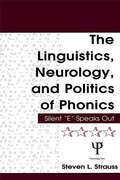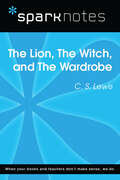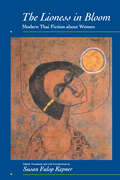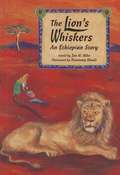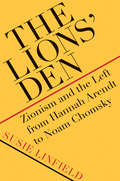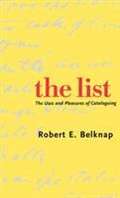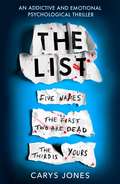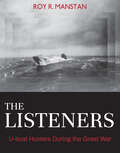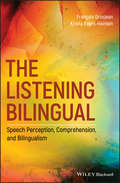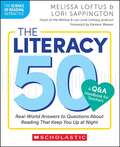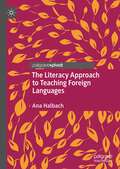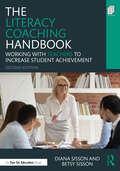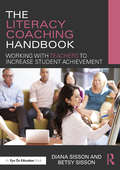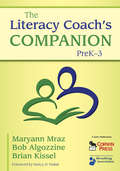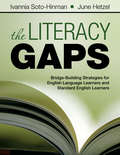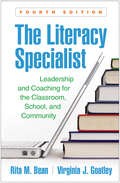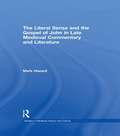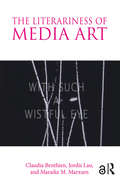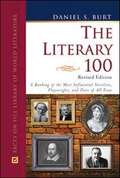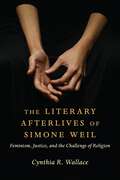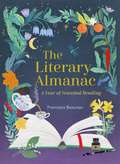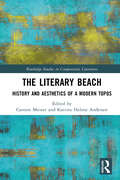- Table View
- List View
The Linguistics, Neurology, and Politics of Phonics: Silent "E" Speaks Out
by Steven L. StraussThis book explores the driving forces behind the current government-sponsored resurrection of phonics, and the arguments used to justify it. It examines the roles played by three key actors--corporate America, politicians, and state-supported reading researchers--in the formulation of what Strauss terms the neophonics political program. Essential for researchers, students, and teachers of literacy and reading, and for anyone seeking to understand what is happening in U.S. public schools today, The Linguistics, Neurology, and Politics of Phonics: Silent "E" Speaks Out:*analyzes the political nature of the alleged literacy crisis in the United States, through an investigation of the political and corporate motives behind the renewed focus on phonics, and media complicity in promoting the neophonics political program as the solution to the so-called crisis;*examines the scientific claims of neophonics, including methodology, linguistics, and neuroscience, and exposes the flaws in its reasoning and the weakness of its arguments;*addresses the scientific, empirical investigation of letter-sound relationships in English (of phonics itself), and demonstrates the complexity of the system and its associated benefits and limitations in the theory and practice of reading;*proposes actions to help make a return to politically undistorted science and to democratic classrooms a reality; and*introduces, in a postscript, a formal analysis of the letter-sound system, using empirically based rules to convert one finite set of elements, the alphabet, into another, the phonemes of the spoken language. Offering up-to-date information and an original critique, this book makes two important contributions. One is the policy analysis linking government agencies, policymakers, and corporate interests. The second is the neurological and linguistic treatment of why traditional phonics programs are not the solution and why the rhetoric developed to support their resurgence is so far off the mark.
The Lion, the Witch, and the Wardrobe (SparkNotes Literature Guide Series)
by SparkNotesThe Lion, the Witch, and the Wardrobe (SparkNotes Literature Guide) by C.S. Lewis Making the reading experience fun! Created by Harvard students for students everywhere, SparkNotes is a new breed of study guide: smarter, better, faster. Geared to what today's students need to know, SparkNotes provides: *Chapter-by-chapter analysis *Explanations of key themes, motifs, and symbols *A review quiz and essay topicsLively and accessible, these guides are perfect for late-night studying and writing papers
The Lioness in Bloom: Modern Thai Fiction about Women (Voices from Asia #9)
by Susan Fulop KepnerKepner's selection shows the many ways fiction has mirrored the lives of Thai women over the twentieth century. The spectrum is broad, encompassing the young and the old, the rural and the cosmopolitan, the privileged and the poor. Some writers address previously unacceptable themes: female sexuality, spousal abuse, gender oppression. Others display a scintillating sense of humor. They touch on many themes—injustice, the heartlessness of society, loneliness, the difficult choices that life presents. Susan Kepner's lyrical, faithful translations preserve the tenor and resonances of these voices, many of which will be heard for the first time by English-speaking readers.
The Lions Whiskers: An Ethiopian Story (Comprehension Power Readers)
by Jan MikeIn this tale from the Amhara people of Ethiopia, a patient Woman uses her experience with a Wild Lion to win the love of her New Stepson.
The Lions' Den: Zionism and the Left from Hannah Arendt to Noam Chomsky
by Susie LinfieldA lively intellectual history that explores how prominent midcentury public intellectuals approached Zionism and then the State of Israel itself and its conflicts with the Arab world In this lively intellectual history of the political Left, cultural critic Susie Linfield investigates how eight prominent twentieth-century intellectuals struggled with the philosophy of Zionism, and then with Israel and its conflicts with the Arab world. Constructed as a series of interrelated portraits that combine the personal and the political, the book includes philosophers, historians, journalists, and activists such as Hannah Arendt, Arthur Koestler, I. F. Stone, and Noam Chomsky. In their engagement with Zionism, these influential thinkers also wrestled with the twentieth century’s most crucial political dilemmas: socialism, nationalism, democracy, colonialism, terrorism, and anti-Semitism. In other words, in probing Zionism, they confronted the very nature of modernity and the often catastrophic histories of our time. By examining these leftist intellectuals, Linfield also seeks to understand how the contemporary Left has become focused on anti-Zionism and how Israel itself has moved rightward.
The List: The Uses and Pleasures of Cataloguing
by Robert E. Belknap"I am no more lonely than the Mill Brook, or a weathercock, or the north star, or the south wind, or an April shower, or a January thaw, or the first spider in a new house," wrote Henry David Thoreau in Walden. In creating this list, and many others that appear in his writings, Thoreau was working within a little-recognized yet ancient literary tradition: the practice of listing or cataloguing. This beautifully written book is the first to examine literary lists and the remarkably wide range of ways writers use them. Robert Belknap first examines lists through the centuries--from Sumerian account tablets and Homer's catalogue of ships to Tom Sawyer's earnings from his fence-painting scheme--then focuses on lists in the works of four American Renaissance authors: Emerson, Whitman, Melville, and Thoreau. Lists serve a variety of functions in Emerson's essays, Whitman's poems, Melville's novels, and Thoreau's memoirs, and Belknap discusses their surprising variety of pattern, intention, scope, art, and even philosophy. In addition to guiding the reader through the list's many uses, this book explores the pleasures that lists offer.
The List: ‘A terrifyingly twisted and devious story' that will take your breath away
by Carys JonesFive names on a list. The first two are dead.The third is yours.A rip-roaring, addictive, intense and emotional thriller for fans of Lucy Foley, Ruth Ware, Phoebe Morgan, CL Taylor and Lisa Jewell...* * * * * * *Beth Belmont runs every day, hard and fast on the trail near home. She knows every turn, every bump in the road. So when she spots something out of place - a slip of white paper at the base of a tree - she's drawn to it.On the paper are five names. The third is her own.Beth can't shake off the unease the list brings. Why is she on it? And what ties her to the other four strangers?Then she discovers that the first two are dead.Is she next?Delving into the past of the two dead strangers, the truth Beth finds will lead her headlong into her darkest, deadliest and most dangerous nightmares...PRAISE FOR THE LIST:'Compelling, unsettling and utterly addictive, The List got deep under my skin as I read it in a single sitting' M W CRAVEN, author of The Puppet Show'A sharp psychological thriller. A captivating premise and an engrossing read with twists and turns that will keep you hooked to the very last page' ADAM HAMDY, author of Black 13'A terrifying story of guilt and remorse. A chilling reminder that the past doesn't always stay there no matter what stories we tell ourselves or others! The truth sits in the shadows and will always come to light' ALEX HART, author of Take Me Home
The List: ‘A terrifyingly twisted and devious story' that will take your breath away
by Carys JonesFive names on a list. The first two are dead.The third is yours.A rip-roaring, addictive, intense and emotional thriller for fans of Lucy Foley, Ruth Ware, Phoebe Morgan, CL Taylor and Lisa Jewell...* * * * * * *Beth Belmont runs every day, hard and fast on the trail near home. She knows every turn, every bump in the road. So when she spots something out of place - a slip of white paper at the base of a tree - she's drawn to it.On the paper are five names. The third is her own.Beth can't shake off the unease the list brings. Why is she on it? And what ties her to the other four strangers?Then she discovers that the first two are dead.Is she next?Delving into the past of the two dead strangers, the truth Beth finds will lead her headlong into her darkest, deadliest and most dangerous nightmares...PRAISE FOR THE LIST:'Compelling, unsettling and utterly addictive, The List got deep under my skin as I read it in a single sitting' M W CRAVEN, author of The Puppet Show'A sharp psychological thriller. A captivating premise and an engrossing read with twists and turns that will keep you hooked to the very last page' ADAM HAMDY, author of Black 13'A terrifying story of guilt and remorse. A chilling reminder that the past doesn't always stay there no matter what stories we tell ourselves or others! The truth sits in the shadows and will always come to light' ALEX HART, author of Take Me Home
The Listeners: U-boat Hunters During the Great War (Garnet Bks.)
by Roy R. ManstanAn untold story of scientists and engineers who changed the course of World War I Roy R. Manstan's new book documents the rise of German submarines in World War I and the Allies' successful response of tracking them with innovative listening devices—precursors to modern sonar. The Listeners: U-boat Hunters During the Great War details the struggle to find a solution to the unanticipated efficiency of the German U-boat as an undersea predator. Success or failure was in the hands and minds of the scientists and naval personnel at the Naval Experimental Station in New London, Connecticut. Through the use of archival materials, personal papers, and memoirs The Listeners takes readers into the world of the civilian scientists and engineers and naval personnel who were directly involved with the development and use of submarine detection technology during the war.
The Listening Advantage: Outcomes and Applications
by Judi BrownellThis outcome-based text offers principles and skill-building experiences for the critical competence of listening. It serves as an adaptable supplement for courses in communication and professional studies. It draws from the author’s HURIER model, which identifies six interrelated components of listening—hearing, understanding, remembering, interpreting, evaluating, and responding—and considers the skills required to achieve the specific outcomes related to each. Varied classroom activities, including discussion questions, group processes, and other instructional strategies, facilitate skill-building and the achievement of each Listening Outcome. The final section of the text identifies those outcomes that are particularly relevant to specific career applications and provides cases to facilitate discussion and illustrate listening challenges in each field. The outcome-based, modular format allows instructors maximum flexibility in adapting instructional materials to meet the needs of specific courses and time frames. The Listening Advantage is an invaluable supplement for courses in communication studies and professional fields including education, healthcare, helping professions, law, management, and service.
The Listening Bilingual: Speech Perception, Comprehension, and Bilingualism
by François Grosjean Krista Byers-HeinleinA vital resource on speech and language processing in bilingual adults and children The Listening Bilingual brings together in one volume the various components of spoken language processing in bilingual adults, infants and children. The book includes a review of speech perception and word recognition; syntactic, semantic, and pragmatic aspects of speech processing; the perception and comprehension of bilingual mixed speech (code-switches, borrowings and interferences); and the assessment of bilingual speech perception and comprehension in adults and children in the clinical context. The two main authors as well as selected guest authors, Mark Antoniou, Theres Grüter, Robert J. Hartsuiker, Elizabeth D. Peña and Lisa M. Bedore, and Lu-Feng Shi, introduce the various approaches used in the study of spoken language perception and comprehension in bilingual individuals. The authors focus on experimentation that involves both well-established tasks and newer tasks, as well as techniques used in brain imaging. This important resource: Is the first of its kind to concentrate specifically on spoken language processing in bilingual adults and children. Offers a unique text that covers both fundamental and applied research in bilinguals. Covers a range of topics including speech perception, spoken word recognition, higher level processing, code-switching, and assessment. Presents information on the assessment of bilingual children’s language development Written for advanced undergraduate students in linguistics, cognitive science, psychology, and speech/language pathology as well as researchers, The Listening Bilingual offers a state-of-the-art review of the recent developments and approaches in speech and language processing in bilingual people of all ages.
The Literacy 50–A Q&A Handbook for Teachers: Real-World Answers to Questions About Reading That Keep You Up at Night
by Melissa Loftus Lori SappingtonTeachers have questions, and nobody knows that better than Melissa Loftus and Lori Sappington, hosts of the popular “Melissa & Lori Love Literacy” podcast. They have assembled the questions teachers ask them most about how children learn to read–and provided solid, evidence-based answers inspired by interviews with their expert guests. Their handy Q&A guide can be read from cover to cover, in sections, or by question, as your schedule allows. Written in a teacher-next-door style, it offers solid advice, references to reliable research, and lots of teaching ideas to put into action immediately. Turn to it as you would a trusted colleague who can answer your most pressing questions about phonemic awareness, phonics, fluency, vocabulary, and comprehension. Understanding the science of reading just got easier and more fascinating, thanks to this essential new book.
The Literacy Approach to Teaching Foreign Languages
by Ana HalbachThis book describes a new approach to teaching foreign languages for primary and secondary school that shifts the attention from learning the language to communicate skillfully in the foreign language. The approach focuses on developing students’ literacy skills as a way to discover language and make it meaningful. In the first four chapters the rationale for the approach is explained and illustrated with examples from different units of work in different languages (French, English and Spanish). Chapter 5 talks the reader through a complete unit of work based on a YouTube video, while chapter 6 looks at how this approach can be integrated into an existing curriculum. The book ends by looking at teachers and their difficulties in implementing this approach, and finally sets the Literacy Approach against recent developments in education. This volume will be of interest to academics, students and teachers in fields including foreign language education, literacy development, and CLIL.
The Literacy Coaching Handbook: Working With Teachers to Increase Student Achievement
by Diana Sisson Betsy SissonLearn how to become a more effective literacy coach to ensure lasting changes in teaching and learning at your school. In this second edition, literacy experts Diana and Betsy Sisson offer clear, research-based strategies that encourage professional development and growth. You’ll discover how to … Understand the various roles that a literacy coach plays, from "change agent" to "data analyst"; Partner with administrators to build a school instructional team; Determine which coaching model to use with your teachers; Support your classroom colleagues and raise student achievement; Tackle the literacy concerns present in today’s schools, and any resistance from classroom teachers who don’t want to be coached; Discover innovative ways to provide multimodal coaching in the digital age; Design a plan to promote growth centered on assessment and collaboration; and Manage the multi-faceted responsibilities of literacy coaching with practical strategies. Each chapter contains special features such as Coaching Moves, Coaching Questions, Working With Administrators, and Additional Readings to help you apply the information to your own situation. In addition, the Appendices offer photocopiable PD tools and study guide questions so you can discuss the ideas with others. With this practical book, you’ll have all the guidance you need to overcome challenges and thrive in your coaching role.
The Literacy Coaching Handbook: Working with Teachers to Increase Student Achievement
by Diana Sisson Betsy SissonLearn how to become a more effective literacy coach to ensure lasting changes in teaching and learning at your school. Literacy experts Diana and Betsy Sisson offer clear, research-based strategies that encourage professional development and growth. You’ll discover how to… Understand the various roles that a literacy coach plays, from "change agent" to "data analyst"; Determine which coaching model to use with your teachers; Support your classroom colleagues and raise student achievement; Tackle the literacy concerns present in today's schools, and any resistance from classroom teachers who don't want to be coached; Design a plan to promote growth centered on assessment and collaboration; and Manage the multi-faceted responsibilities of literacy coaching with practical strategies. Each chapter contains special features such as Coaching Moves and Coaching Questions to help you apply the information to your own situation. In addition, an Appendix offers photocopiable PD tools and study guide questions so you can discuss the ideas with others. With this practical book, you'll have all the guidance you need to overcome challenges and thrive in your coaching role.
The Literacy Coach’s Companion, PreK–3
by Bob Algozzine Maryann E. Mraz Brian T. KisselA concise reference with essential protocols for successful early literacy coaching! This book highlights the expanding role of literacy coaches in implementing early and elementary literacy programs. The authors present user-friendly guidelines and evidence-based strategies for sustained professional development, protocols for classroom observations and teacher conferences, and vignettes offering solutions to common coaching challenges. This resource illustrates how coaching professionals can: Define an effective, proactive role in promoting literacy initiatives Strengthen content knowledge and coaching skills to support teachers’ efforts and students’ literacy development Collaborate with teachers and school leaders to establish productive learning communities Communicate their changing roles to administrators
The Literacy Gaps: Bridge-Building Strategies for English Language Learners and Standard English Learners
by Ivannia M. Soto June HetzelBuild bridges of support so English language learners and standard English learners can learn alongside their peers! This comprehensive, research-based guide helps teachers bridge multiple gaps and promote learning for English language learners (ELLs) and standard English learners (SELs). The authors provide strategies, examples, and tools to address: <p><p> The gap between students and texts: covering word recognition, background knowledge, comprehension, and academic language development <p> The gap between students and teachers: including sociocultural differences between teachers and students and teacher perceptions and expectations <p> The gap between students and their peers: discussing language proficiency differences, grouping strategies, and grade-level and schoolwide programs
The Literacy Specialist, Fourth Edition: Leadership and Coaching for the Classroom, School, and Community
by Rita M. Bean Virginia J. GoatleyThe definitive practitioner resource and text for developing excellence as a PreK–12 literacy/reading specialist is now updated to reflect key changes in the field. Delving into the literacy specialist's multiple leadership roles, the book provides strategies for teaching children experiencing difficulty with reading and writing; supporting teachers through coaching and professional learning opportunities; designing curricula; conducting assessments at the student, classroom, and school levels; and building strong school, family, and community partnerships. Pedagogical features include vignettes from exemplary practitioners, questions for discussion and reflection, follow-up activities, and ideas for instructors and workshop leaders. Reproducible forms and worksheets can be downloaded and printed in a convenient 8½" x 11" size. Previous edition title: The Reading Specialist, Third Edition. New to This Edition *Broader view of literacy now encompasses reading, writing, oral language, and digital and visual literacies. *Grounded in the International Literacy Association's updated Standards 2017. *New or expanded discussions of multi-tiered systems of support, culturally responsive practice, uses of technology in instruction and professional learning, successful practices in middle and high school settings, and coaching. *Extended case example that follows one literacy specialist through her entire first year in a school. *Appendix with website resources.
The Literacy Teacher's Playbook Grades K-2: Four Steps For Turning Assessment Data Into Goal-Directed Instruction
by Jennifer SerravalloThis workshop-in-a-book shares a powerful approach to assessment, planning, and teaching. Go beyond curriculum to develop differentiated reading and writing goals then plan targeted instruction with the four-step assessment protocol: *collect data-student work and everyday assessments-that will be the most useful to you *analyze the data to understand deeply what kids know and can do *synthesize data from multiple assessments to create learning goals *develop instructional plans and follow-ups to monitor progress.
The Literal Sense and the Gospel of John in Late Medieval Commentary and Literature (Studies in Medieval History and Culture #12)
by MArk HazardFirst Published in 2003. Routledge is an imprint of Taylor & Francis, an informa company.
The Literariness of Media Art
by Claudia Benthien Jordis Lau Maraike M. MarxsenThe beginning of the 20th century saw literary scholars from Russia positing a new definition for the nature of literature. Within the framework of Russian Formalism, the term ‘literariness’ was coined. The driving force behind this theoretical inquiry was the desire to identify literature—and art in general—as a way of revitalizing human perception, which had been numbed by the automatization of everyday life. The transformative power of ‘literariness’ is made manifest in many media artworks by renowned artists such as Chantal Akerman, Mona Hatoum, Gary Hill, Jenny Holzer, William Kentridge, Nalini Malani, Bruce Nauman, Martha Rosler, and Lawrence Weiner. The authors use literariness as a tool to analyze the aesthetics of spoken or written language within experimental film, video performance, moving image installations, and other media-based art forms. This volume uses as its foundation the Russian Formalist school of literary theory, with the goal of extending these theories to include contemporary concepts in film and media studies, such as Neoformalism, intermediality, remediation, and postdrama.
The Literary 100: A Ranking of the Most Influential Novelists, Playwrights, and Poets of All Time
by Daniel S. BurtBurt (literature, Wesleyan University) updates his 2001 edition of the one hundred most influential writers of all time, adding twenty-five to the list. To decide on whom to include, Burt polled both other scholars and students. In the end, he also relied on his own judgment. While most of the writers are from the Western tradition, he also includes African, Chinese and Japanese works, all of which are available in English translations. The entries are arranged idiosyncratically. Each one contains a portrait (if possible) and begins with a quotation either from or about the author. Burt gives a thumbnail sketch of the person's life and work, along with the reason why he or she was selected. Annotation ©2009 Book News, Inc., Portland, OR (booknews.com)
The Literary Afterlives of Simone Weil: Feminism, Justice, and the Challenge of Religion (Gender, Theory, and Religion)
by Cynthia R. WallaceThe French philosopher-mystic-activist Simone Weil (1909–1943) has drawn both passionate admiration and scornful dismissal since her early death and the posthumous publication of her writings. She has also provoked an extraordinary range of literary writing focused on not only her ideas but also her person: novels, nonfiction, and especially poetry. Given the challenges of Weil’s ethic of self-emptying attention, what accounts for her appeal, especially among women writers?This book tells the story of some of Weil’s most dedicated—and at points surprising—literary conversation partners, exploring why writers with varied political and religious commitments have found her thought and life so resonant. Cynthia R. Wallace considers authors who have devoted decades of attention to Weil, such as Adrienne Rich, Annie Dillard, and Mary Gordon, and who have written poetic sequences or book-length verse biographies of Weil, including Maggie Helwig, Stephanie Strickland, Kate Daniels, Sarah Klassen, Anne Carson, and Lorri Neilsen Glenn. She illuminates how writing to, of, and in the tradition of Weil has helped these writers grapple with the linked harms and possibilities of religious belief, self-giving attention, and the kind of moral seriousness required by the ethical and political crises of late modernity. The first book to trace Weil’s influence on Anglophone literature, The Literary Afterlives of Simone Weil provides new ways to understand Weil’s legacy and why her provocative wisdom continues to challenge and inspire writers and readers.
The Literary Almanac: A year of seasonal reading
by Francesca BeaumanDiscover over 300 seasonal book recommendations in the ultimate reading list for book lovers everywhere.-----'I will be giving this book to everyone I know' - Elizabeth Day'Francesca Beauman writes about the books she loves with irresistible passion, knowledge and warmth ... This is the best kind of reading celebration' - Rachel Joyce-----Spanning the dreary, cold days of January to the first flushes of spring and then the blazing August heat, bibliophile Francesca Beauman offers up a wealth of book recommendations. From The Count of Monte Cristo to Elena Ferrante's Neapolitan Quartet, each has been selected to chime with a particular time of year and provide a richer reading experience. Beautifully illustrated throughout, this charming guide will delight, inspire and seriously extend your 'To Be Read' list!
The Literary Beach: History and Aesthetics of a Modern Topos (Routledge Studies in Comparative Literature)
by Carsten Meiner Katrine Helene AndersenAs a geo-historical place, the beach integrates a variety of characteristics and functions so multiple that they tend to contradict each other. The beach is both a place of work and trade but also of leisure; it is both a place of therapy and health but also of migration, war, and death; it is a place of mass tourism and boredom but also the place of experiencing the Other; it is a public place but also an uncivilized and desolate place.This book studies the literary representation of the beach from ancient Greek literature up until today, drawing on English, French, Italian, American, and Spanish literatures from various periods and genres and presenting multiple ways of comparing and understanding literary beaches as a ubiquitous literary phenomenon. It demonstrates how the literary beach as a both geo-historical place and as an aesthetic literary commonplace has been a constant and privileged resource for the analysis of more general existential, sociological, and moral problems. This is the case when for instance the Tahitian beach becomes the place of the "already modern" in Stevenson's tales, or when the Italian beach becomes a question of modern feminism in Ferrante.In this sense, literature expands the local or national beach by articulating its transnational complexities.
